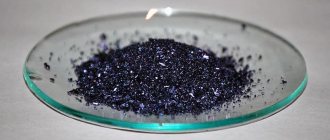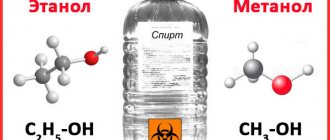Even a small amount of alcohol ingested into the body is harmful to humans. Ethanol is famous for its destructive and toxic effects on the functioning of internal organs; it also poisons the human central nervous system. But the most serious and dangerous condition develops when an intoxicated person is poisoned by alcohol-containing products.
The market is full of low-quality substitute alcohol, which, due to its cheapness, often ends up on people’s tables. And even among elite vodka you can find fakes. According to statistics, almost half of cases of such intoxication are fatal. How to recognize alarming symptoms in time and what to do in case of vodka poisoning?
Vodka poisoning is one of the most dangerous human conditions.
Causes and symptoms of intoxication
Why does alcohol poisoning occur in adults? There are several reasons and factors that provoke this phenomenon.
Factors:
- Chronic consumption of vodka leads to the accumulation of toxic substances in the body,
- Excessive consumption in a short period of time,
- Drinking vodka during treatment with medications,
- Ethyl alcohol intolerance
- The most common poisoning occurs from burnt vodka. People with alcohol addiction buy it because of the low price; consuming such a product leads to an overdose.
In case of vodka poisoning, symptoms appear gradually. The intensity depends on the degree of overdose and the amount of alcohol taken. (what are the causes of beer poisoning)
Signs:
- Speech problems
- Increased sweating
- Head spinning
- Nausea, gag reflex,
- Loss of coordination
- spots on the skin,
- Respiratory dysfunction
- Reduced body temperature,
- Cold sticky sweat
- Reduced blood pressure,
- Convulsive manifestations
- Changing the size of the pupils,
- In case of severe vodka intoxication, a coma may develop.
An acute form of poisoning requires immediate help and contact a medical facility.
How to recognize a fake
There are signs by which you can determine the originality of vodka even before purchasing it, simply by examining the bottle:
1. Cost. Good vodka cannot be cheap. If you are going to buy vodka of a certain brand, then it is best to check its average cost on the Internet. But there are also cases when counterfeit alcohol is sold at the price of the original. In this case, you need to carefully examine the appearance of the bottle.
2. Place of purchase. In a small store or market, the likelihood of buying a low-quality fake is much greater. Therefore, refrain from shopping in such places.
3. Look at the vodka inside the bottle. Presence of sediment and cloudiness is not allowed. High-quality vodka should be crystal clear without any tints in color. Turbidity or lack of purity in color indicates poor quality of the alcohols and water used.
4. Cover. The easiest way to determine the quality of vodka is by the cap. Good alcohol always has a quality cap. It is tightly closed and adheres to the neck of the bottle. Counterfeits, as a rule, do not have a dispenser, while the originals almost always have a dispenser.
5. The label matters too. It should be glued evenly and neatly. All inscriptions are straight and without errors. The back label must indicate the manufacturer's address, as well as the composition of the drink (the presence of any chemical ingredients is not allowed). The colors on the label should be bright. The bottle date and batch number must be indicated on the label and on the lid; they must match.
6. Excise stamp. It is mandatory for high-quality vodka to have a high-quality excise stamp. It should be glued evenly, the text on it should be neat and not smeared.
7. Many well-known vodka producers use various methods to protect themselves from counterfeit. These are usually various engravings or relief images on the bottle, holograms. You can find out about all these protection measures on the official websites of the manufacturers. There you can also see the original shape of the bottle and its design.
Considering all these tips, you can choose high-quality vodka that will not harm your health, but will leave only a positive impression.
Recently, in the press and on the Internet, reports of poisoning with surrogate alcohol are increasingly appearing. Experts say that almost half of all vodka available for sale is counterfeit. Drinking it, at best, ends in a severe headache. However, most people poisoned by such vodka become disabled. It happens that poisoning ends in death.
Not only chronic alcoholics are poisoned with surrogate alcohol. Those who do not understand how to distinguish counterfeit from pure vodka fall into the category of victims. It should be noted that surrogate producers are improving their “skills,” but there are still signs that allow one to determine the quality of vodka already in the store. What are they?
When buying vodka in a store, you need to be able to determine the quality of the drink so as not to purchase alcohol that is hazardous to your health. It is advisable to learn to recognize a counterfeit before purchasing. In order to protect yourself from poisoning, several rules should be followed.
- You can't buy vodka just anywhere. Stalls and small shops on the outskirts are ideal points for trading in surrogate. In supermarkets and large stores, customers are given a receipt. They will not risk their reputation, since in case of poisoning this receipt can be presented and proven the time and place of purchase of vodka.
- Don't skimp on cheap vodka. If it costs much less than vodka of the same brand in other stores, then it is a fake. The seller may say that the product came directly from the supplier, which is why it has such a low price. You can't trust him. It is quite possible that the origin of the vodka is completely unknown to the seller.
- When purchasing alcohol, you must carefully inspect the bottle. Official manufacturers create a specific degree of protection. You can find out what it should be on specialized websites. When checking the bottle, you should pay attention to the cork. If it is scratched, it means the bottle was closed by hand. In production this is done with special equipment.
Bottles of expensive vodka are laser marked. The letters and numbers printed on them are created from black dots. They do not wipe off and do not leave a mark on your fingers. Labels on dishes with expensive alcohol are glued evenly. Products from well-known manufacturers are protected by a hologram. The glue strips on the label are located at the same distance from each other. The paper is coated with a layer of varnish.
High-quality vodka is bottled on a conveyor belt, filling bottles to a certain level. If the store has bottles filled differently on the same shelf, it is better to refuse to buy it. Real alcohol is completely transparent. To check the vodka, you need to turn the bottle over and hold it for a few seconds. If streaks appeared on the glass, the color of the liquid changed, crystals became visible, and a sediment—burnt vodka. If you shake the bottle vigorously, large bubbles will likely flow through it. In normal vodka they will be small. But what to do if the vodka has already been purchased? How to check it at home?
Clinical picture of poisoning with surrogates
Symptoms of poisoning with burnt vodka differ from signs of intoxication with a quality product due to the fact that surrogate substances have an effect on the body.
Methyl alcohol
The substance is most often included in low-quality vodka. The smell of the substance is similar to the smell of ethanol, so a person cannot immediately notice that he is consuming a toxic substance.
Signs:
- Visual impairment is the first symptom of a methanol overdose.
- Painful sensations in the abdomen, vomiting, nausea, intestinal dysfunction.
- Serious disturbances in the functioning of the nervous system, convulsions, coma. In case of severe poisoning, death is possible.
Ethylene glycol
The substance is part of various glass cleaners, antifreezes, and chemical solvents. People who are heavily dependent on alcohol and do not pay attention to the quality of alcohol can become poisoned by it.
Symptoms:
- Excitement, nausea, vomiting, intestinal upset.
- Lack of urine output or excretion of a small amount due to severe impairment of kidney function.
- The presence of edema, the skin becomes yellowish.
- Poisoning by surrogates can lead to the death of the victim in the absence of first medical aid.
Signs of palenka that you should pay attention to in the store
You can recognize a fake even at the stage of purchasing the product, if you approach the choice of drink responsibly. When purchasing vodka in a store, you should pay attention to the following signs of adulteration of strong alcohol:
- Label. On a counterfeit product, the label is often attached crookedly, and traces of glue are visible on the bottle. The strips of adhesive under the paper backing are applied unevenly to the glass, which is easily visible through the liquid.
- Cork. On fake vodka, the cork fits unevenly to the bottle, allows alcohol to pass through and twists.
- Price. High-quality alcohol cannot be cheap. If vodka is sold in one store much cheaper than the same drink in other retail outlets, then there is a high probability that it is counterfeit.
- Excise stamps on “scorched” vodka are most often pale and indistinct, the golden stripe on them is painted on, and not made as a separate element, the hologram glitters, but does not shimmer.
- Lettering on the bottle. If the bottling date and time on the label do not match the information on the cork, this indicates a counterfeit product.
- Engraving. This sign can only be noticed by those who prefer to constantly purchase the same brand of vodka. Some large factories make raised engravings on the bottles with various information about the drink and the manufacturer. It is impossible to fake an engraving on glass, since this requires special equipment. If a bottle of a well-known drink does not have the usual inscriptions, this indicates falsification.
First aid at home
An overdose of vodka requires prompt assistance to avoid the development of adverse consequences. What to do at home in case of such poisoning? Depending on the degree of intoxication, help varies.
Stages:
- In case of mild poisoning, it is enough to lavage the stomach and provide rest to the poisoned person.
- The average degree of overdose requires cleansing the stomach; it is permissible to use enemas to quickly remove the toxin. After washing, various adsorbents are used to get rid of vodka.
- In case of severe poisoning, treatment is carried out in a hospital setting. It will not be possible to provide full assistance at home.
What kind of help can be provided at home?
Help:
- If the poisoned person is conscious, then his stomach is cleansed. The patient drinks a large amount of water, vomiting is provoked. The procedure is performed several times. Such cleansing cannot be carried out if the person is unconscious or has a impaired swallowing reflex.
- The victim is given various sorbents to take - Activated carbon, Smecta, Enterosgel. The substances will prevent vodka from being absorbed into the mucous wall of the stomach and intestines.
- The use of cleansing enemas is allowed; they are done until clean water comes out.
- In any case, the victim is given plenty of fluids to drink. In case of severe vodka intoxication, call an ambulance.
- The victim is placed on his side so that he does not choke on vomit, the mouth is cleansed of saliva, and the tongue is released.
- In severe poisoning, the functioning of the heart muscle is often disrupted. If necessary, resuscitation is carried out - indirect cardiac massage, artificial respiration.
Timely first aid will help save a person’s life and protect him from unpleasant consequences.
Other falsification methods
With falsification, another situation is possible, when there is so much water in the drink that there is almost no alcohol. Another manipulation with water is that the manufacturer can dilute ethanol or methanol with a liquid that does not meet the requirements of the technology, that is, it will not be purified to the required degree.
The water for making the original product is carefully prepared. It is softened, eliminating excess hardness (for example, silver cleaning), in some cases it is completely cleaned, then trace elements are added. At the final stage, the finished product can be cleaned with milk powder. This helps rid the vodka of impurities while preserving the taste and smell. The original products do not have a strong odor, much less one that resembles acetone.
Some manufacturers may add additives to vodka to highlight their products and influence consumer choice in their favor. These components affect the increase in price, but it should be taken into account that sometimes such mark-up is not justified: in some cases, the task of such additives is to hide the poor quality of the product, the smell of acetone.
In addition, falsification methods include non-compliance with the recipe (for example, not putting in enough sugar). It is also possible to replace one substance with another (sugar with honey, if it is provided for in the recipe, etc.).
Vodka poisoning: medical assistance
Medical workers provide first aid before arriving at the hospital.
Actions:
- Lavage of the stomach through a tube in the absence of consciousness in the victim,
- Use of a ventilator if necessary,
- Using medications to stop the gag reflex
- Medications are administered intravenously to replenish fluid in the body.
If there are no results from first aid and the patient’s condition is serious, the patient is sent to a medical facility.
Treatment is carried out in intensive care or a toxicology department and includes a set of various measures.
Measures:
- Carrying out tests to accurately determine the toxin,
- In case of methanol poisoning, an antidote is administered - ethanol,
- Hemodialysis is carried out - purification of the blood from breakdown products of vodka,
- Various medications are prescribed to restore the functionality of the gastrointestinal tract,
- Dietary nutrition is selected, it is recommended to drink plenty of fluids.
- Vitamin therapy is used during the recovery process.
Consequences and prevention
Excessive consumption of vodka leads to various consequences, some of which are irreversible.
What could be:
- Changes in the mucous membrane of the gastrointestinal tract, in the absence of therapy - development of peptic ulcer,
- Constantly high blood pressure
- Development of heart diseases
- Memory problems
- Pathological processes in the limbs,
- Hepatitis in chronic form.
Preventative measures for poisoning are quite simple. It is necessary to carefully choose alcoholic drinks, do not drink cheap alcohol. If possible, it is better to avoid drinking vodka altogether, especially if you have liver and kidney diseases.
Vodka poisoning can lead to the death of a person in the absence of the necessary help. It is recommended to be careful with alcohol and not consume more than the permissible dose.
How to distinguish from the real one
First, let's figure out what signs indicate that the alcohol presented is scorched. You can recognize a fake at the initial stage, before purchasing the product, if you take the choice of product seriously. When purchasing strong alcohol in a supermarket or store, first of all pay attention to the following signs indicating the falsification of strong alcohol.
- The cap on a bottle of alcohol twists slightly and may also not fit tightly to the neck.
- The bottling stamp indicated on the label may not match the stamp printed on the cap.
- The label is glued to the bottle crookedly; strips of glue applied unevenly may be visible.
- The label looks dull and the font is fuzzy and worn out. Today, this sign is rare, since counterfeiters have improved their skills in this matter.
- The inscriptions on the label are written incorrectly. It is quite common to replace some letters or replace them in places in the name of a branded product.
- The liquid in the glass container is cloudy, not crystal clear, and also has a yellowish tint.
- A scorched drink very often has sediment or foreign microparticles may float in it.
- Burnt alcohol tastes less strong.
- After 2-3 days after opening the strong drink, the liquid acquires a matte color.
Video: shock, vodka poisoning with Elena Malysheva
Read further:
Vodka with salt for intestinal disorders
Donormil overdose











